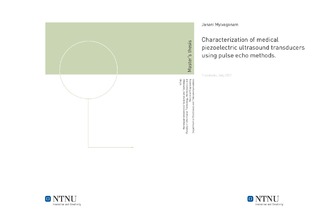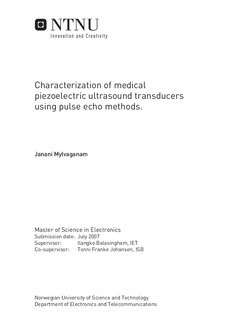| dc.description.abstract | In this thesis, a measurement set-up has been developed to characterize high frequency medical ultrasound transducers using a pulse echo set-up. This work is a continuation of an earlier project. The aim of this project is to improve the instrumentation to get more reliable, repeatable and consistent results. The transducer used in this project was a 20MHz annular array transducer with 8 elements. Parameters such as the electroacoustic transfer function and reflection coefficients of element 1 and 2 have been found for a sinusoidal burst excitation and a Gaussian excitation, to give examples for the estimation of these parameters. Developing the right instrumentation for the pulse echo set-up and transducer for pulse echo measurements has been emphasised, where a transducer holder and reflector have been constructed for characterization of elements 1-5. A cylindrical water resistant reflector with a curved top was designed giving certain degrees of freedom as opposed to the pure spherical reflector concerning positioning of the reflector with respect to the transducer. A slanted bottom was included in the design of the reflector causing reflections from the bottom to diffract and thus stopping these from interfering with the reflections of interest happening at the top of the reflector surface. A transducer holder was also designed and custom made for the transducer used in the project, where both mechanical and electrical considerations have been taken, as the holder makes alignment of the transducer with respect to the reflector easier and coaxial cables have been introduced to get more control over the signals going to and from the transducer array. Coaxial cables were chosen as these are easy to model, and have clear specifications in addition to having the property of shielding noise signals. Alignment of the transducer has been emphasised to make radiation into the focus of the reflector easier, although the design of the reflector also allows the reflector to be tilted in the allocation of its focus point. By taking detailed lateral scans of echoes received by the transducer using a robot, in addition to varying the distance between the transducer and the reflector with an increment of 0.2 mm, the reflection coefficients were found to be very sensitive to lateral positioning, and to some extent sensitive to axial positioning of the transducer with respect to the reflector. The elimination of propagation delay due to the signals travel in waterpath and electrical transmission and reception chain leading to the transducer ports has also been compensated for, as these delays will effect the complex values of the transfer function. The electrical propagation delay is eliminated by using a simulation program, and analysis of the time between two consecutive echoes is done in order to find the physical time delay in the water path the pulses travelled. The electro acoustic transfer function has also been found for element 1 and element 2, but with a much greater time delay than what was expected. An uncertainty budget of the obtained parameters has also been done to see the impact of laboratory equipment on the meaurements. Estimation schemes to obtain reflection coefficients and the electro acoustic transfer function have been developed, which are repeatable for further characterization for the whole transducer array. Existing MATLAB codes have been modified in simulations and some new codes have been written for analyzing measurement based estimation of transfer functions, reflection coefficients and effects of various filters on their characteristics. Different types of filters have been used on the recorded echo signals to eliminate noise from the estimated reflection coefficients. A better control of the parasitic inductances due to the non coaxial cables in the system should perhaps be evaluated, and for further characterization of the transducer, the mechanical admittance can also be found by using the estimated reflection coefficients and electro acoustic transfer function. | nb_NO |

